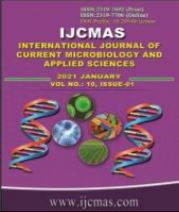


 National Academy of Agricultural Sciences (NAAS)
National Academy of Agricultural Sciences (NAAS)

|
PRINT ISSN : 2319-7692
Online ISSN : 2319-7706 Issues : 12 per year Publisher : Excellent Publishers Email : editorijcmas@gmail.com / submit@ijcmas.com Editor-in-chief: Dr.M.Prakash Index Copernicus ICV 2018: 95.39 NAAS RATING 2020: 5.38 |
To assess the relationship between Body Condition Score (BCS) and postpartum changes of goats under field conditions, a study was conducted on goat flocks of farmers in and around Prakasam district. The postpartum changes studied in BCS of 60 does which were divided into three groups (Group I- 2.50-2.99, Group II- 3.00-3.49 and Group III- 3.50-3.99) based on BCS showed that the does were in the BCS range of 2.50 – 3.75 at kidding. Does in the test flock were in the BCS range of 2.50 – 3.75 at kidding, reduced their body condition during early lactation and so the minimum BCS of 2.00 – 2.99 was recorded for majority of the does (55). The mean BCSK was 3.11 which was decreased to 2.87 at first week postpartum, further decreased to 2.42 by 12 weeks postpartum and later on increase gradually to 2.80 by 18 weeks postpartum. LBCS of the test flock ranged from 0.50 to 1.00 with a mean value of 0.70. GBCS of the test flock ranged from 0.25 to 0.50 with a mean value of 0.38. Minimum BCS of the test flock ranged from 2.00 to 3.00 with a mean value of 2.41. A significant (P < 0.01) difference was observed between the does of different groups of BCSK in LBCS, GBCS and minimum BCS. The mean BCS was decreased from first week to 10 weeks postpartum for the does of BCSK 2.50 to 2.99, from first week to 11 weeks postpartum for the does of BCSK 3.00 to 3.49 and from first week to 12 weeks for the does of BCSK 3.50 to 4.00, thereafter showed an increased trend for the does of three BCSK groups. The highest loss as well as gain in BCS was achieved by the BCSK group 3.50 to 4.00 compared to the BCSK group 2.50 to 2.99 and 3.00 to 3.49.
 |
 |
 |
 |
 |